The clarinet is a versatile instrument, used in orchestras, concert bands, and even jazz ensembles. Generally speaking, the term “clarinet” refers to the Bb (B-flat) clarinet, which was created in the early 17th century.
However, as is common with instruments invented long ago, a huge number of different variations of clarinets have been developed along the way: clarinets of different sizes, ranges, and concert pitches.
Some are found in just about every band and orchestra in Western music, some were popular but are starting to fall out of favor, and some are so rare that you’ll probably never see one in person.
In this post, we’re going to cover all the different types of clarinet that exist and give you an overview of each one, what makes it different, and how it’s commonly used.
The Clarinet Family
The clarinet family is structured similarly to that of the saxophone family.
There are three main ranges which are:
- Soprano clarinets
- Alto clarinets
- Bass clarinets
Some are even higher and lower, but this sort of nomenclature is used informally as general terms.
All of the instruments in the clarinet family share certain qualities.
They’re all single reed woodwind instruments, which means that one reed is affixed to the instrument’s mouthpiece and blown through to create sound.
Most quality clarinets are usually made of wood, with a cylindrical bore ending in a bell.
Clarinets change pitch by the opening and closing of holes along the body of the instrument; some of these holes are sealed by pads attached to keys and others are sealed directly by the player’s fingers.
Nearly every clarinet is a transposing instrument.
With this in mind, let’s take a look at the most common clarinets.
Common Clarinets
Below is our list of what we think are the most common types of clarinets that you’re likely to see in bands and orchestras around the world.
The Clarinet in Bb
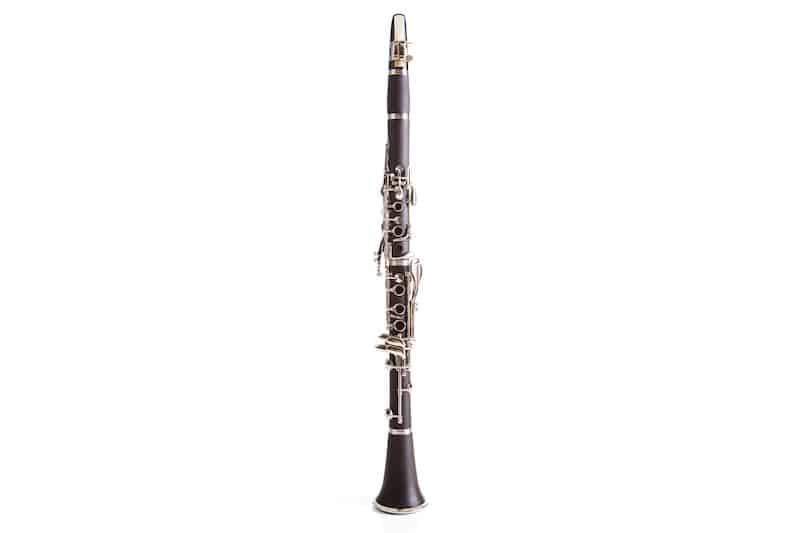
The most common and recognizable type is the Bb clarinet. We call it “the Bb clarinet” because it is a transposing instrument which means that when you play a C on the clarinet, it actually sounds a concert Bb pitch.
It’s also considered a soprano clarinet and its range is strikingly wide.
The written Bb clarinet range begins at D3 (the D below middle C) and ends on Bb6 (the second Bb above the treble clef staff).
Fingerings in different octaves don’t repeat, as the clarinet has a register key that raises the pitch an octave and a fifth.
It is the most common type of clarinet for beginners, and as a standard band or orchestra has two at minimum, many concert bands seat ten to fifteen Bb clarinetists (spread across three written parts).
The Clarinet in A

Up next we have the Clarinet in A, called so because when you play the note C on it it actually sounds a concert A.
It’s almost identical to the Bb clarinet in looks except that it’s ever so slightly longer.
It also differs in that it’s pitched just a half step below the common Bb clarinet. This means that its range is the same (except that it begins and ends a half step lower) from C#3 to A6.
Its timbre (tone color) is different than the Bb, but only by a little and it’s often used in pieces that are written in “sharp keys” as opposed to the Bb clarinet which will play in “flat keys”.
The Eb Soprano Clarinet
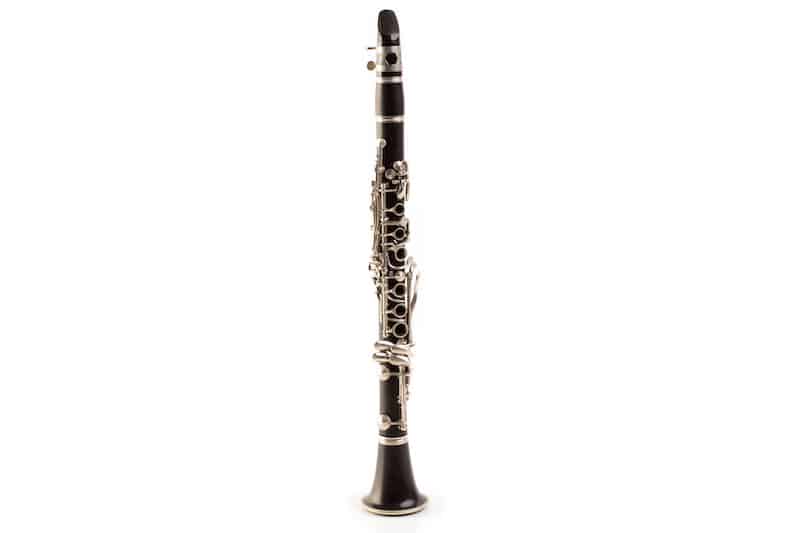
Not quite as common but still found in orchestras is the Eb Clarinet, again called so because when you play an Eb it sounds a concert C.
Sometimes called a “sopranino” or the “piccolo” clarinet, it’s quite small and at a lot higher pitch than the previous two clarinets we looked at.
Its written range looks slightly lower than the Bb clarinet, from G3 to Eb7.
The Eb clarinet is included in many European scores by its Italian name, the terzino, or terzino in Mib (mi being the solfege for E in the fixed do system).
This clarinet can be included in all kinds of orchestras and bands.
Since it’s pretty tricky to play in tune, it’s mostly used in clarinet choirs to play high parts more comfortably than they are on the Bb clarinet.
The Alto Clarinet in Eb
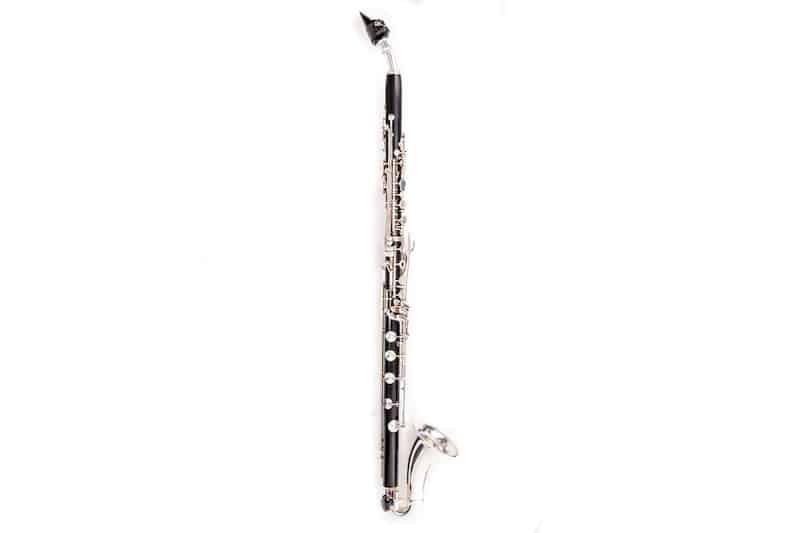
Next, we have the Alto Clarinet. Like the Soprano clarinet in Eb, when you play an Eb on the alto clarinet it sounds a concert C.
Pitch-wise, it plays between the Bb clarinet and the bass clarinet (which we’ll look at next) and its range is from Gb2 to Bb5.
Visually, it looks like a smaller version of the bass clarinet, with a bent metal neck and a curved metal bell.
You’ll usually see it being used in concert bands and smaller chamber ensembles but rarely in orchestras.
Band directors claim that alto clarinets are more fragile, that they’re harder to play in tune, that the tonal color is lost in the sound of the other clarinets, that the range can be covered by the Bb and bass clarinets, and the list goes on.
This led to fewer clarinetists specializing in the alto clarinet, and with the reduced demand for parts, composers generally stopped writing for them further decreasing the demand.
However, if you program a concert or marching band piece composed before the 1980s, it’s pretty likely to have an alto clarinet part.
Related: The best clarinet for intermediate players.
The Bass Clarinet
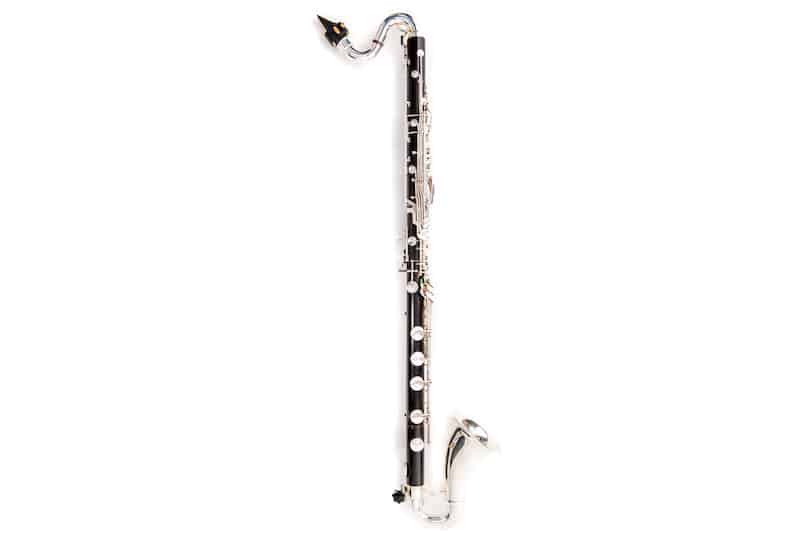
Another clarinet that occupies the bass clef staff is called the Bass Clarinet. The common bass clarinet is also in Bb and so when it plays a Bb it sounds a concert C.
The bass clarinet also has a written range that looks similar to that of the Bb clarinet, but it sounds an octave and a second lower than the written pitch. The written range is C2 to A6, but it sounds from Bb1to G5.
Other than the range, it has a few things in common with the Bb soprano clarinet notably of which is that it uses the same fingerings, with the addition of a few keys that extend its range.
It is considerably larger than the Bb soprano. Instead of a straight barrel, the bass clarinet has a curved metal neck.
Instead of a short bell, it sports a curved bell that looks similar to a saxophone’s bell. To support its weight, the bass clarinet has an endpin that rests on the floor.
Related: Check out our list of best bass clarinets here.
Contrabass and Contra-Alto Clarinets
Continuing lower, we have two fairly common clarinets, albeit much less than the others above which are the contrabass and contra-alto clarinets.
They look like extreme versions of the bass clarinet, with very long necks and bells that nearly reach the height of the mouthpiece.
A contrabass clarinet measures over 7.5 feet tall and so is quite the imposing instrument!
Range wise it can play a minor third below the bass clarinet and as a result, they both have rich, warm, deep sounds, and are usually only used in bands and clarinet choirs.
While common in the early 1900s, a decrease in contra clarinet parts lead to a big decline in production, leading the ones that exist today to be treated as antiques.
Uncommon Clarinet Types
Now that we’ve looked at the more common clarinet types, we’ll take a look at some of the very uncommon ones that you’re unlikely to see but do exist.
Sopranino Clarinet in Ab
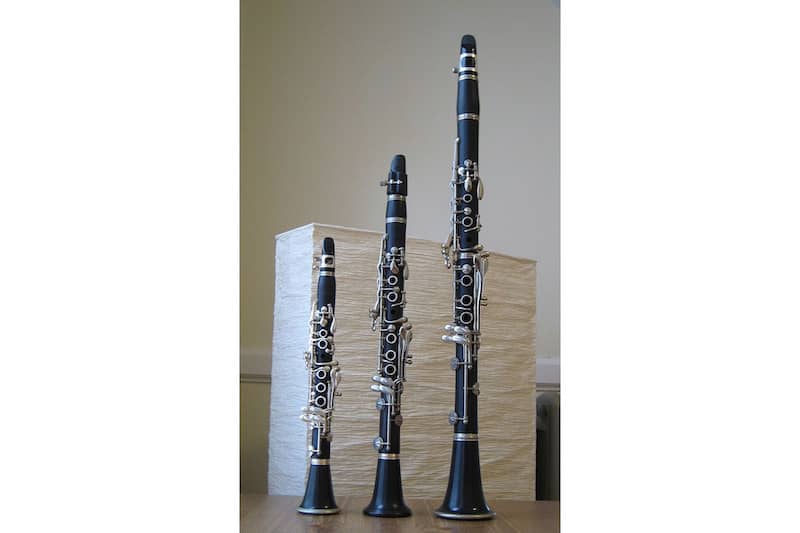
An Ab (a-flat) sopranino clarinet exists, but it’s usually used purely as a feature in pieces by composers who were big fans (Béla Bartók and Giuseppe Verdi being two) or by virtuoso clarinetists.
As you can see in the image above (with an Eb and Bb clarinet to the right) it’s absolutely tiny and measures about twelve inches long from bell to mouthpiece.
Range wise it plays at a considerably higher pitch due to its small length with a range a minor seventh above the Bb clarinet with it has a much higher, thinner, and brighter timbre.
You’re very unlikely to see it used much today as its tone and pitch take quite a bit of work to control but it was popular in Italian military bands.
The Basset Clarinet and Horn
A very uncommon type of clarinet is the Basset Clarinet. Basset clarinets feature extra keys so that lower notes can be played on a soprano-sized clarinet.
The most common basset clarinet is in A, but there are also versions in C, Bb, and most rarely, G.
You can also get Basset horns which are also considered clarinets. They look similar to the alto clarinet and have the same kind of low note extensions. You usually find ones in F, but some are in G and D.
Octocontrabass and Octocontra Alto Clarinets
Lastly on our list of clarinets, we have the Octocontrabass and Octocontralto Clarinets that are even bigger and lower than contra clarinets!
These are experimental instruments and are incredibly rare with only a few even having been made.
It’s believed that only one of each survives today so to see or hear one in person is next to impossible, but there are photos and videos of them being played like the video above.
Summing Up The Clarinet Family
That’s it for our article on the clarinet family, we hope it helped explain some of the differences and similarities between them all.
It’s surprising how many other types there are as most people only think there is the one.
Now that you know a few others you’ll probably see them popping up more and more. That being said, a lot of the clarinets in the list above haven’t really caught on with composers and so there aren’t many pieces written for them.
For example, The D clarinet was only included in one major work (Stravinsky’s “The Rite of Spring”) and was never really used outside of it.
Just like the uncommon types listed above, unless you study clarinet professionally at the collegiate level and beyond, it’s unlikely you’ll play them.
The Bb and bass clarinet, however, can be found in just about any band or orchestra in the western world and are a very standard instrument for new musicians to learn as a first instrument.


